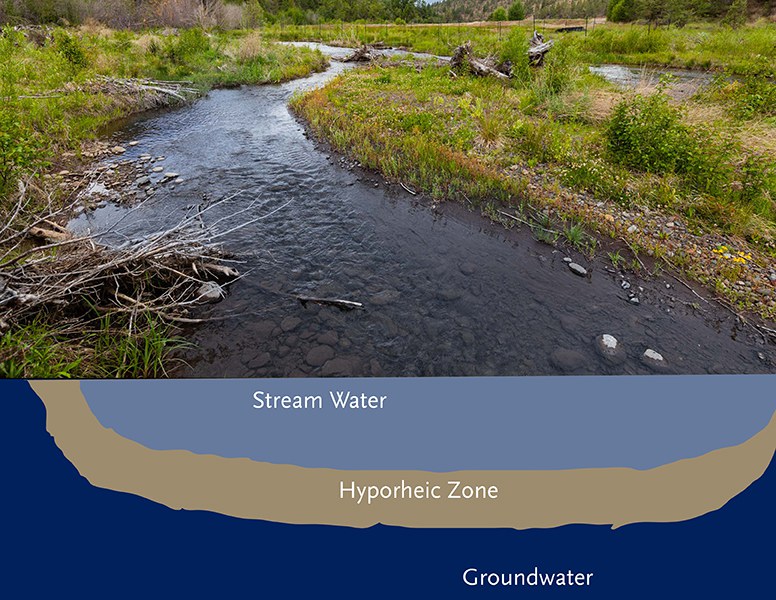When looking at the Land Trust’s stream restoration projects, we’ve discussed the importance of woody debris in our streams and why groundwater matters. Now, we’re going to dive into the hyporheic zone—what it is and its critical importance as part of our streams.
The hyporheic zone is an area underneath and alongside a stream bed that is made up of sediment and porous space where shallow groundwater and surface water mix. This sediment can be large and small, but is permeable enough to allow an exchange of water, nutrients, and dissolved oxygen. In the hyporheic zone, there is a downwelling of surface water and an upwelling of groundwater, which creates the mixing of these two waters. Here’s a visual of where the hyporheic zone exists:

The hyporheic zone is critically important to the health of our waterways. Not only does it cycle energy, nutrients, and organic compounds, but it also helps moderate stream temperatures, improves water quality, and provides a unique habitat within our streams.
The aquatic food web is mainly fueled by leaves, twigs, and other organic matter that falls into the stream. As this debris rots, the dissolved compounds include organic carbon and nitrogen that needs to be transformed into forms that can be used by algae and other plants. The microbes that perform this job are usually attached to rocks or wood as biofilm (the slippery material on stream rocks). However, stream currents on the surface of the water often move too quickly for the biofilm to be able to transform these compounds. In the hyporheic zone, though, the water moves slowly enough for the microbes to be able to perform their job. These nutrients are then pushed back into the surface water of the stream and utilized by other creatures.
The exchange of surface water and groundwater is a critical component of our streams. As the colder groundwater mixes with the warmer surface water within the hyporheic zone, it keeps the stream cooler in the summer and warmer in the winter. This is of particular importance to salmon and other fish species, who rely on colder stream temperatures in the summertime.
The hyporheic zone is important to salmon for another reason. It is the habitat for salmon during their earliest life stages. When salmon dig out gravel to lay their eggs, they are actually laying their eggs in the hyporheic zone. This keeps the eggs safe from predators, as well as from floating away on swift currents. The water temperature exchange in the hyporheic zone also regulates the water temperature for the eggs and provides oxygen. Once the eggs have hatched, the salmon larvae, known as alevins, stay in the hyporheic zone to grow bigger and stronger while remaining protected from predators.
In addition to being a habitat for salmon eggs and alevins, there are a diverse range of creatures that call the hyporheic zone home, including many small invertebrates like mites, isopods, and amphipods. The hyporheic zone has also been identified as a refuge for some bottom-dwelling stream invertebrates during low flows, heat waves, and floods.
Pollutants are also removed from the stream by bacteria that live in the hyporheic zone, improving the water quality. The bacteria are able to degrade or even consume some stream contaminants.
The hyporheic zone’s size and ability to perform its natural functions are influenced by many things, including whether the stream is straight or meanders, if there is a single channel or it is multi-braided, if the stream has woody debris or is free of debris, and how porous the streambed is. In addition, the hyporheic zone’s size and function is affected by the morphology and geology of the area.
As you might have noticed, our stream restoration projects—which focus on returning Whychus Creek to a meandering, multi-braided stream with woody debris— can also strengthen the hyporheic zone’s function. This function is critical to the Land Trust’s restoration goals, enabling a healthier, more resilient stream that supports a wide variety of wildlife.
Sources:
- Following a River Wherever It Goes: Beneath the Surface of Mountain Streams, Steve Wondzell, Science Findings, October 2004
- The Hyporheic Zone and Streams, Karen E. Jackson, Clemson University Cooperative Extension
- Is the Hyporheic Zone Relevant Beyond the Scientific Community?, multiple authors, Water, 2019.
Learn more:
- Watch a video on the hyporheic zone
- Why Groundwater Matters
- Wood is Good: The Importance of Woody Debris in Streams


